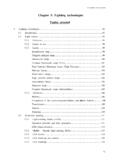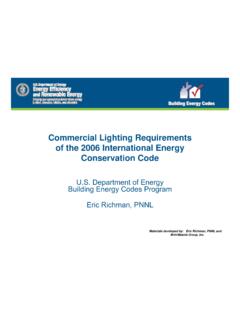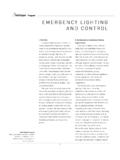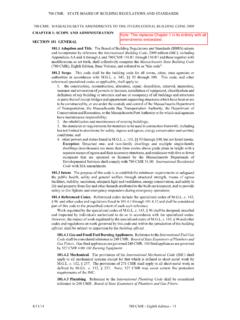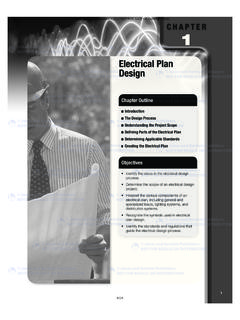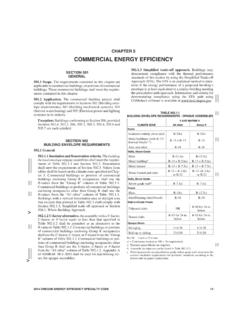Transcription of 4 lighting and energy standards and codes - Aalto …
1 4 lighting and energy standards and codes 57 Chapter 4: lighting and energy standards and codes Topics covered 4 lighting and energy standards and codes .. 59 Review of lighting standards 59 59 Data collection .. 60 Method .. 61 Display using world 61 Recommended illuminance levels .. 70 energy codes and policies .. 70 Europe energy performance of buildings directive .. 70 energy efficient building codes and policies in the US .. 71 energy efficient building codes and policies in China .. 71 energy efficient building codes and policies in Brazil .. 71 energy efficient building codes and policies in South Africa .. 72 25 energy Efficiency Policy Recommendations by IEA to THE G8.
2 72 energy -related legislation in the European Union .. 73 73 EuP Directive .. 73 energy performance of 76 EN 15193- energy requirements for lighting LENI .. 76 energy Efficiency Label .. 78 Disposal phase of lighting Equipment in Europe .. 78 78 RoHS Directive .. 78 WEEE 79 Notes .. 81 Review of standards on electric and electromagnetic aspects .. 81 IEC 81 CENELEC standard .. 82 European Union EMC 82 ANSI/IEEE standards .. 82 Harmonic Currents Limits .. 83 4 lighting and energy standards and codes 58 Examples of lighting related energy programs .. 85 energy STAR .. 85 Top Runner 86 References .. 87 4 lighting and energy standards and codes 594 lighting and energy standards and codes Review of lighting standards worldwide Introduction The major international organization in charge of coordinating the management of standards , recommendations, and technical reports in the field of lighting is the Commission Internationale de l Eclairage (CIE).
3 The CIE has published several recommendations for indoor lighting and has contributed to a joint ISO-CIE standard ISO 8995-1 (CIE, 2001/ISO 2002) concerning indoor working places. The CIE publications related to indoor lighting are listed below: CIE 49-1981: Guide on the Emergency lighting of Building Interiors CIE 52-1982: Calculations for Interior lighting : Applied Method CIE 55-1983: Discomfort Glare in the Interior Working Environment CIE 60-1984: Vision and the Visual Display Unit Work Station CIE 117-1995: Discomfort Glare in Interior lighting CIE 123-1997: Low vision - lighting Needs for the Partially Sighted CIE S 008/E: 2001/ISO 8995-1:2002(E): lighting of Work Places - Part 1: Indoor CIE 146/147:2002 : CIE Collection on Glare 2002 CIE 161:2004: lighting Design Methods for Obstructed Interiors CIE S 010/E:2004/ ISO 23539.
4 2005(E): Photometry - The CIE System of Physical Photometry CIE 097:2005: Maintenance of Indoor Electric lighting Systems, 2nd Edition CIE S 009 / E:2002 / IEC 62471:2006: Photobiological Safety of Lamps and Lamp Systems ISO 11664-2:2008(E)/CIE S 014-2/E:2006: CIE Standard llluminants for Colorimetry CIE 184:2009: Indoor Daylight Illuminants The recommendations of the CIE have been interpreted in different manners in different countries. Hence some differences exist among lighting recommendations worldwide. Furthermore, in the North America, the Illuminating Engineering Society of North America (IESNA) is active in developing its own recommendations. The best known documents are the IES lighting Handbooks which are regularly updated.
5 The working groups of the IESNA have their own references and it is quite typical that some approaches differ from those of the CIE. For example, IESNA uses the term Visual Comfort Probability (VCP) for glare rating issues (Rea 2000), whereas the CIE glare rating is called the Unified Glare Ratio (UGR) (CIE 1995). 4 lighting and energy standards and codes 60 In the Annex 45 work the lighting recommendations worldwide were compared. The comparison is useful in identifying the potential for amending these standards , considering the growing need for the increasing energy efficiency of lighting . The review focused on office buildings. Data collection The first task was to collect the documents presenting national lighting recommendations from different countries through network of experts, and to translate the various published criteria of non-English documents into English.
6 The lighting recommendation data was collected from eleven countries/regions, including both industrialised and developing countries. The collected documents related to indoor lighting recommendations from different countries are listed below. Argentina: Tonello, G. y Sandoval, J., Recomendaciones para iluminaci n de oficinas Asociaci n Argentina de Luminot cnia (AADL), 1997. Australia: AS/NZS Interior lighting - Safe movement AS Interior and workplace lighting - General principles and recommendations. AS Interior lighting : Part - Recommendations for specific tasks and interiors. AS Interior lighting : Part Circulation spaces and other general areas. AS Interior lighting - Office and screen-based tasks AS Interior lighting : Part Educational and training facilities Brazil: CIE : Guide on Interior lighting China: GB 50034-2004 Standard for lighting design of buildings.
7 Europe: EN 12464-1:2002: Light and lighting - lighting of work places- Part 1: Indoor Work Places. India: IS 3646 (Part 1):1992, code of practice for interior illumination: Part 1 General requirements and recommendations for working interiors. National Building code of India 2005 (NBC 2005) Part 8, Section 1 Japan: JIES-008 (1999)- Indoor lighting Standard. Nepal: Gupta, Electrical installation estimation and costing, Kataria & Sons. New Delhi 1995, 7th edition. Russia: SNiP 23-05-95 Daylight and Artificial lighting : Construction standards and Rules of Russian Federation. South Africa: 4 lighting and energy standards and codes 61 SANS 10114-1:2005 - code of Practice for Interior lighting .
8 USA: ANSI/IESNA RP-1-04, American National Standard Practice for Office lighting . Method The Table shows various lighting parameters which were selected in collecting the data. Specifications for collecting data were divided into three categories: individual needs, social needs and environmental needs. Display using world maps Details of the lighting recommendations for office lighting are presented in Appendix A. In order to give a general view of the consistency of and differences in specifications in lighting standards and codes across the world, the main recommended values are presented on world maps, Figures 4-1 4-7. ISO/CIE standard recommendation values are also presented in the map for comparison with the national/regional recommendations.
9 Most lighting recommendations include specifications on: Minimum illuminance levels on work planes (Figure 4-1) Minimum illuminance when working on computers (Figure 4-2) Minimum illuminance in the surroundings (Figure 4-3) Luminance ratios near task areas (Figure 4-4) Glare rating (Figure 4-5) Luminances on the ceiling and shielding angle (Figure 4-6) Indoor surface reflectance (Figure 4-7) These specifications are essential, since they impose the measures to maintain the quality of lighting . These measures are the production of minimum quantities of light (lumen) in room and in task areas, recommendations in the distribution of the light in the task and surrounding areas, recommendations on the glare, etc.
10 4 lighting and energy standards and codes 62 Table 4-1. Various lighting parameters selected in collecting the data from the national lighting recommendations. A. INDIVIDUAL NEEDS Illuminance (horizontal) on task area Illuminance ( vertical) on task area Illuminance (horizontal) on computer ( keyboard, mouse) Illuminance for drawing Illuminance of immediate surroundings VISUAL PERFORMANCE Illuminance (vertical) on screens Luminance ratio on the task area (luminances on walls, ceilings, task plane, etc.) Ceiling luminance Maximum luminance from overhead luminaries Maximum wall luminance Maximum window luminance Recommended surface reflectances Specification of flicker-free light sources Illuminance uniformity on the task area Discomfort Glare Rating Discomfort glare in the case of use of Visual Display Terminals (VDT) Control of reflected glare and veiling reflections VISUAL COMFORT Possible specifications regarding lighting fixtures Color rendering index (CRI) Correlated color temperature(CCT)
